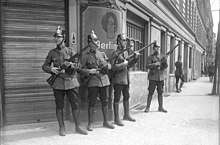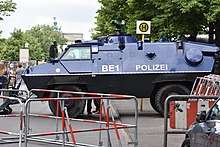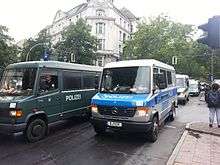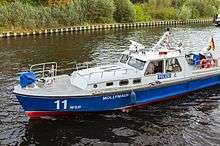Berlin Police
The Berlin Police (German: Der Polizeipräsident in Berlin -The Police Chief of Berlin-, or commonly Berliner Polizei) is the German Landespolizei force for the city-state of Berlin. Law enforcement in Germany is divided between federal and state (Land) agencies.
| Der Polizeipräsident in Berlin | |
|---|---|
| Agency overview | |
| Formed | 25 March 1809 |
| Employees | 25,153 (2017)[1] |
| Annual budget | €1.545 billion (2019)[2] |
| Jurisdictional structure | |
| Operations jurisdiction | Berlin |
 | |
| Location of Berlin shown in Germany | |
| Size | 891.85 km² |
| Population | 3,754,418 (2019) |
| Governing body | Senate of Berlin |
| Constituting instruments |
|
| General nature |
|
| Operational structure | |
| Headquarters | Platz der Luftbrücke 6 12101 Berlin |
| Agency executive |
|
| Facilities | |
| Cars | 2,500 |
| Website | |
| Official website | |
The Berlin Police is headed by the Police President, Barbara Slowik. Her deputy is Police Vice-President Michael Krömer. They are supported in the management of the force by the Staff Office of the Police President, the Commanders of the six Local Divisions, the Division for Central Tasks, the Criminal Investigation Department and the Central Services Division.
History
The Royal Prussian Police of Berlin was founded on 25 March 1809 with Justus Gruner as the first chief of police.
In March 1848 Berlin was one of the places where the Revolution of 1848 took place (also called the March Revolution). At this time just a small number of police officers (approx. 200 officers for 400,000 citizens) with limited authority, the so-called Revierpolizei (literally police station police) existed. To fight the revolution, the chief of police, police commissioner Dr. Julius Freiherr von Minutoli asked the Prussian Army for help. They sent two guard cavalry regiments (the Regiment Gardes du Corps (cuirassiers), the 1. Garde-Dragoner Regiment "Königin Victoria von Großbritannien und Irland" (dragoons)), and three guard infantry regiments (1. and 2. Garderegiment zu Fuss, Kaiser Alexander Garde-Grenadier-Regiment Nr.1). Approximately 230 citizens were shot or killed by sabers because the guard troops had orders to, "Immer feste druff!" (~ Strike them hard!). After a couple of days the troops withdrew and a militia ("Bürgerwehr") with a strength of 20,000 men was founded. In short, the militia was worthless.
Shortly after the revolution, King Frederick William IV of Prussia founded the "Königliche Schutzmannschaft zu Berlin" in June 1848. It was the first modern police force in Germany from the viewpoint of then and today. It consisted of 1 Oberst (colonel), 5 Hauptleuten (captains), 200 Wachtmeister (sergeants) and 1,800 Schutzleute (officers), 40 of them mounted.
In 1936, during the Nazi regime it was dissolved like all other German police forces, and absorbed into the Ordnungspolizei or Orpo. The Orpo was established as a centralized organisation uniting the municipal, city, and rural uniformed forces that had been organised on a state-by-state basis. Eventually the Orpo embraced virtually all of the Third Reich's law-enforcement and emergency response organizations, including fire brigades, coast guard, civil defense, and even night watchmen. It was under the overall command of Heinrich Himmler.[3]
After the fall of the Berlin Wall (1989) and the Reunification of Germany (1990), the West Berlin police, with 20,000 employees, and the East Berlin police, with 12,000 employees were merged under the direction of the West Berlin chief Georg Schertz.[4] Approximately 2,300 officers changed assignments from the West to the East, and approximately 2,700 from the East to the West. About 9,600 East Berlin officers were checked for being possible collaborators of the MfS (Stasi). 8,544 of them were cleared, while 1,056 were not. Approximately 2,000 were retired or resigned on their own.
The law on the Freiwillige Polizei-Reserve Berlin (FPR):[5] (volunteer police reserve) of 25 May 1961 in West Berlin created a paramilitary organization to protect important infrastructure like power plants and drinking water supplies. Since the eighties it became more of a branch in which citizens were able to voluntarily support the Schupo in daily service. It was disbanded in 2002.
Police chiefs

List of police chiefs since 1809:
1809–1920
|
|
Greater Berlin: 1920–1948
|
|
Divided Berlin: 1948–1990
|
West Berlin:
|
East Berlin:
|
Since 1990
|
|
Organization

Directorates
Berlin Police is divided into 6 local directorates (Direktion). Each local directorate is responsible for one to three Berliner districts:
- Direktion 1: Reinickendorf, Pankow[6]
- Direktion 2: Spandau, Charlottenburg-Wilmersdorf[7]
- Direktion 3: Mitte[8]
- Direktion 4: Tempelhof-Schöneberg, Steglitz-Zehlendorf[9]
- Direktion 5: Friedrichshain-Kreuzberg, Neukölln[10]
- Direktion 6: Marzahn-Hellersdorf, Treptow-Köpenick, Lichtenberg[11]

Each Direktion had several Abschnitte (precincts, all in all 38) where the patrol car staff (Schutzpolizei/Schupo) is located. Other sub departments of a Direktion are (not all listed):
- Referat Verbrechensbekämpfung - detective branch (Kriminalpolizei/Kripo) and plainclothes units of the Schupo.
- Referat Zentrale Aufgaben - central services:
- Verkehrsdienst - traffic police
- Direktionshundertschaft - a company special police
- Diensthundführer - K9
Workforce
.jpg)
- 17,041 police officers in uniform and plain clothes (2017)[1]
- 2,526 security guards, prison-officers and staff in other law-enforcement related areas (2017)[1]
- 2,778 administrative staff, including management and clerical staff, technical staff and scientists of various disciplines (2017)[1]
- 2,808 apprentices and trainees (2017)[1]
- 2,500 vehicles (2017)[1]
- 1.545 Billion Euro annual budget (2019)[2]
Units
- Landeskriminalamt (LKA):[12] The criminal investigations division is responsible for investigating the most serious crimes (exclusive tasks of the LKA like crimes against the constitution, organized crime, youth gangs or political motivated crime f.e.) and works closely with the six local directorates. The LKA supervises police operations aimed at preventing and investigating criminal offences, and coordinates investigations involving more than one Direktion.


Dedicated to the LKA:
- Spezialeinsatzkommando (SEK) - The SWAT teams of the German state police.
- Mobiles Einsatzkommando (MEK) - The MEKs are plainclothes teams of the LKA with special tasks like mentioned above and special manhunt units f.e.
- Personenschutzkommando - Personal security plainclothes unit, protecting politicians and VIPs f.e.
- Direktion Zentrale Aufgaben (Dir ZA):[13]
The directorate central operations has the following sub branches:
- Bereitschaftspolizei (BePo) - Uniformed units (two battalions, each with 4 companies and an engineer unit) that provide additional manpower for the Schupo, natural disasters, sporting events, traffic control or demonstrations (riot/crowd control).
- Wasserschutzpolizei (WSP) - The river police for patrolling rivers, lakes and harbours.
- Zentraler Verkehrsdienst - The traffic police with many sub departments for (just examples): Honor escorts during state visits, Autobahnpolizei (highway police), tracing for vehicles without insurance or known drivers without a license, specialized units for the controlling of vehicles with hazardous materials,
- Diensthundführer - K9
- Polizeihubschrauberstaffel Berlin (PHuSt BE) - The Berlin Police run a Eurocopter EC135 helicopter together with the Bundespolizeipräsidium Berlin.
- Objektschutz/Gefangenenwesen - The Berlin Police has a special branch for the guarding of buildings, especially embassies or watch over and transport convicts. These non-sworn officers are employees with limited police authority. They are armed and wear the same uniform as the Schupo but different rank insignias.
- Zentrale Serviceeinheit (ZSE):[14] The central service unit is responsible for all administrative and logistical support. The general education and training are in charge through the police academy in Berlin.
See also
- Babylon Berlin
- Politics in Berlin
- List of law enforcement agencies in Germany
- Law enforcement in Germany
- Landespolizei (German state police forces)
- Stadtpolizei (German municipal police forces)
References
- "Barbara Slowik ist Berlins neue Polizeipräsidentin".
- "2018/2019 Band 4 - Einzelplan 05".
- Williams, Max (2001). Reinhard Heydrich: The Biography: Volume 1, Ulric, p. 77.
- (in German) Infos and brief history of Berlin Police Archived January 22, 2012, at the Wayback Machine
- (in German) Freiwilliger Polizeidienst Berlin website
- (in German) Polizeidirektion 1 Archived January 16, 2012, at the Wayback Machine
- (in German) Polizeidirektion 2 Archived January 21, 2012, at the Wayback Machine
- (in German) Polizeidirektion 3 Archived January 22, 2012, at the Wayback Machine
- (in German) Polizeidirektion 4 Archived January 1, 2012, at the Wayback Machine
- (in German) Polizeidirektion 5 Archived January 16, 2012, at the Wayback Machine
- (in German) Polizeidirektion 6 Archived January 1, 2012, at the Wayback Machine
- (in German) Landeskriminalamt Berlin Archived January 16, 2012, at the Wayback Machine
- (in German) is an "overregional directorate" Direktion Zentrale Aufgaben Berlin Archived July 19, 2012, at Archive.today
- (in German) Zentrale Serviceeinheit Berlin Archived April 20, 2012, at the Wayback Machine
External links
| Wikimedia Commons has media related to Berlin state police. |
- (in German) Berlin Police official website
- Berlin Police logo (from De.wiki)
- Berlin: Metropolis of crime 1918 - 1933 Part 1, Part 2 (warning: graphic depiction of murder and other violence), a Deutsche Welle English television documentary discussing advances in police methods and forensic technology, corruption in the police force, and selected investigations in Berlin during the early interbellum period